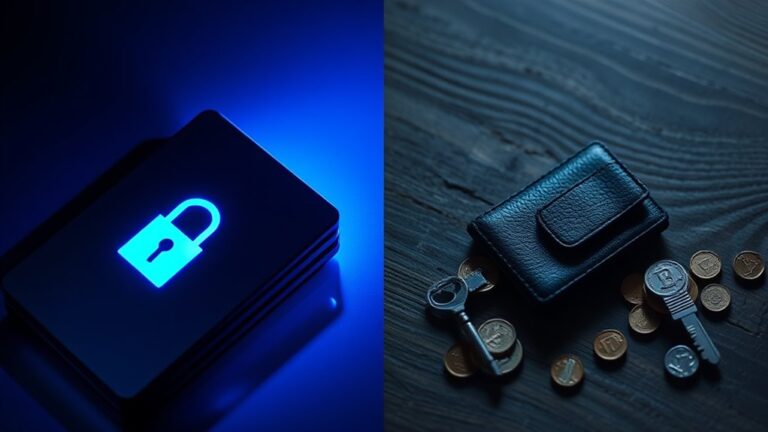
Common Crypto Wallet Scams: 5 Ways to Protect Yourself
Common crypto wallet scams include phishing, fake exchanges, and cloud mining frauds. To protect oneself, individuals should employ strong passwords, enable two-factor authentication, avoid public Wi-Fi, regularly update wallet software, and consider using cold wallets. Users must watch for red flags, such as unrealistic promises or poorly crafted messages. Conducting thorough research before investing is essential for safeguarding assets. Understanding these measures can help investors navigate the risks associated with cryptocurrency scams, leading to more informed decisions.
Key Takeaways
- Implement strong, unique passwords for your crypto wallet to enhance overall security against unauthorized access.
- Enable two-factor authentication (2FA) to add an extra layer of protection against potential scams.
- Conduct thorough research on wallets and projects before investing to identify legitimate opportunities.
- Bookmark trusted websites to avoid phishing attacks and ensure you access the correct platforms.
- Use cold wallets for offline storage of cryptocurrencies to protect against online threats.
Understanding Common Types of Crypto Wallet Scams

How can individuals protect themselves from the growing number of crypto wallet scams? Understanding the common types of scams is the first step.
Phishing scams frequently target users through emails or texts containing fake links that lead to fraudulent websites. These sites often ask for sensitive information like private keys, resulting in stolen cryptocurrencies.
Additionally, fake exchanges and wallets can closely mimic legitimate platforms, initially allowing withdrawals but later blocking them to trap users.
Cloud mining scams also pose risks, promising high returns from mining investments that are never delivered. Implementing strong, unique passwords and enabling two-factor authentication (2FA) can significantly enhance your wallet’s security against these scams.
Identifying Red Flags in Potential Scams

Identifying red flags in potential scams is essential for anyone traversing the cryptocurrency landscape, as awareness can greatly reduce the risk of falling victim to fraudulent schemes.
One major warning sign is the presence of fake websites that closely mimic legitimate platforms, often lacking transparency and contact information. Additionally, unrealistic promises of guaranteed returns can signal potential scams, as can unsolicited communications urging quick investment decisions.
Platforms with poorly crafted messages or excessive celebrity endorsements should also raise suspicion. Moreover, a lack of a clear white paper or team legitimacy can indicate deceit. Staying informed about common threats like phishing attacks and exchange hacks is also crucial for protecting your assets.
Protecting Yourself From Phishing Attacks

Phishing attacks represent a significant threat in the cryptocurrency world, prompting users to take proactive steps to safeguard their assets. Awareness of common phishing techniques and strengthening security measures are essential.
| Phishing Technique | Description | Prevention Method |
|---|---|---|
| Email Phishing | Fraudulent emails mimic trusted sources. | Verify sender before clicking links. |
| Fake Websites | Imitate legitimate platforms to collect data. | Bookmark trusted sites for access. |
| SMS Phishing (Smishing) | Text messages lure users to harmful links. | Avoid sharing personal info via text. |
Implementing strong passwords along with two-factor authentication can further enhance your protection against these phishing attacks.
Safeguarding Your Investment Decisions

Safeguarding investment decisions in the cryptocurrency market is essential for minimizing risks and maximizing potential returns.
Investors should utilize cold wallets, such as hardware wallets, to keep their cryptocurrencies offline, preventing unauthorized access and online theft. Conducting thorough research on projects and their teams is important, as reading white papers and examining community feedback can reveal potential red flags. Additionally, understanding the differences between hot and cold wallets can help investors choose the best storage option for their needs.
Diversifying investments across multiple cryptocurrencies mitigates risks associated with market volatility, ensuring that no single asset jeopardizes the entire portfolio. Staying vigilant against scams is imperative; recognizing common tactics and verifying the legitimacy of platforms can protect investments.
Engaging with reputable financial advisors can also provide valuable insights, empowering investors to make informed decisions in this dynamic market.
Implementing Effective Preventive Measures

Implementing effective preventive measures is essential for anyone involved in the cryptocurrency market, as these strategies can greatly reduce the risk of falling victim to scams.
Users should start by employing strong, unique passwords for their wallets and enabling two-factor authentication for added security. It is advisable to avoid public Wi-Fi and guarantee secure connections when accessing wallet services. Regularly updating wallet software helps protect against vulnerabilities.
Additionally, users can enhance security through biometric authentication. Staying informed about common scams, such as phishing and fake exchanges, is equally important. Moreover, considering the use of multisig wallets can provide an additional layer of security by requiring multiple signatures for transaction approvals.
Frequently Asked Questions
How Can I Recover Lost Funds From a Scam?
Recovering lost funds from a scam requires documenting evidence, reporting to authorities, and notifying involved platforms. Engaging reputable recovery services and ensuring account security through password changes and two-factor authentication are essential for preventing further losses.
Are There Any Legal Actions Against Crypto Scammers?
Legal actions against crypto scammers are not just a ripple in the ocean; they represent a tidal wave of justice. Authorities collaborate intensely, employing advanced techniques to combat fraud, seeking to protect vulnerable investors and uphold integrity.
What Are the Signs of a Legitimate Crypto Project?
Signs of a legitimate crypto project include a transparent and experienced team, detailed documentation like a whitepaper, strong community engagement, a clear utility, and market presence demonstrated through partnerships and listings on trusted exchanges.
Can I Trust Cryptocurrency Influencers?
In a hypothetical scenario, a novice investor follows an influencer’s advice, resulting in significant losses. Trusting cryptocurrency influencers is risky; their knowledge may be limited, and hype often overshadows long-term investment value. Caution is essential.
How Often Do Scams Affect New Cryptocurrency Users?
Scams considerably affect new cryptocurrency users, with a 2023 report indicating that approximately 80% of targeted individuals suffered financial loss. The prevalence of deceitful tactics highlights the vulnerability of inexperienced investors in the market.
Conclusion
In summary, awareness and vigilance are essential in protecting oneself from crypto wallet scams. According to a report from Chainalysis, approximately $14 billion in cryptocurrency was lost to scams in 2021 alone, highlighting the severity of the issue. By understanding common scams, recognizing red flags, and implementing preventive measures, individuals can greatly reduce their risk. Educating oneself about the landscape of cryptocurrency is vital for making informed investment decisions and safeguarding financial assets against potential threats.












